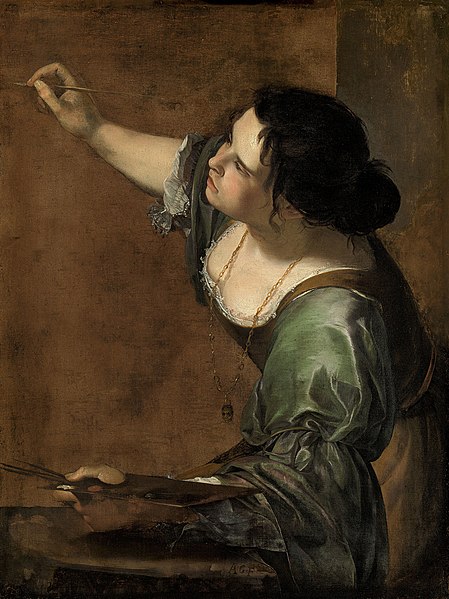
Born: 8 July 1593, Rome
Died: c. 1656 (aged ~63)
Period: Baroque
The Life of Artemisia Gentileschi
Artemisia Gentileschi (1593–1653) stands out as one of the most accomplished painters of the Italian Baroque period and as a pioneering figure among female artists. Born in Rome to Orazio Gentileschi, a well-known painter, Artemisia was introduced to painting in her father’s workshop, a rare opportunity that set the stage for her groundbreaking career.
From an early age, Artemisia displayed exceptional talent, but her path was not without significant challenges. In 1611, she was raped by Agostino Tassi, a painter and associate of her father. The subsequent trial in 1612, during which Artemisia was subjected to a sibille (a form of torture used to verify her testimony), garnered public attention and has since been a focal point in discussions about her life and work. Despite this trauma, Artemisia’s determination to succeed as an artist remained undeterred.
After the trial, Artemisia married Pietro Antonio di Vicenzo Stiattesi, and the couple moved to Florence, where Artemisia’s career flourished. She became the first woman to join the Accademia delle Arti del Disegno in Florence, an unprecedented achievement that underscored her exceptional skill and the respect she commanded among her peers. In Florence, she enjoyed the patronage of influential figures, including the Medici family and Michelangelo Buonarroti the Younger, and developed a reputation for her vivid depictions of strong and suffering women from myths and the Bible, such as “Judith Slaying Holofernes.”
Artemisia’s style is characterized by her use of dramatic lighting, intense emotion, and powerful, often heroic, female figures. Her works are deeply personal, reflecting her own experiences and challenges as a woman in a male-dominated field. She often infused her paintings with a sense of resilience and defiance, resonating with contemporary and modern audiences alike.
Throughout her career, Artemisia worked in various cities, including Venice, Naples, and even London, where she briefly joined her father at the court of Charles I. Her work was widely acclaimed during her lifetime and fell into relative obscurity before being rediscovered and celebrated in the 20th century as part of a broader reassessment of women’s contributions to art history.
Artemisia Gentileschi’s legacy is profound. As a virtuoso painter who navigated and overcame the constraints imposed on women of her time, she broke barriers and laid the groundwork for future generations of female artists. Her life and oeuvre continue to inspire studies, novels, films, and discussions, celebrating her resilience, talent, and indelible impact on the art world.
Artemisia Gentileschi‘s Notable Works
Artemisia Gentileschi, celebrated for her compelling narratives and technical prowess, created a body of work that remains influential and admired. Her paintings, often depicting strong and complex female figures from history and mythology, stand as a testament to her skill and innovative approach to Baroque art. Here are ten of her most famous works:
- “Judith Slaying Holofernes” (c. 1614-1620) – This powerful painting, existing in two versions, depicts the biblical story of Judith beheading the Assyrian general Holofernes. It’s celebrated for its dramatic intensity and the vivid portrayal of female strength.
- “Susanna and the Elders” (1610) – Created when Artemisia was only 17, this work shows Susanna harassed by two elders while bathing. It’s noted for its emotional depth and the dignified portrayal of its subject.
- “Lucretia” (c. 1621) – This painting portrays the Roman heroine Lucretia in the moment before she takes her own life. It’s a poignant study of virtue and honor, rendered with profound empathy.
- “Judith and Her Maidservant” (c. 1625) – In this work, Artemisia captures the tense moment after Judith’s beheading of Holofernes, emphasizing themes of courage and solidarity among women.
- “Self-Portrait as the Allegory of Painting” (La Pittura) (c. 1638-1639) – This self-portrait, where Artemisia represents herself as the personification of painting, is a bold statement of her identity as an artist.
- “Cleopatra” – Artemisia portrayed Cleopatra in several works, focusing on the moments of her demise. These paintings are notable for their emotional intensity and the dignified portrayal of their subject’s final moments.
- “Mary Magdalene in Ecstasy” (c. 1620-25) – This work depicts Mary Magdalene lifted in a moment of spiritual ecstasy, highlighting Artemisia’s ability to convey complex emotional states.
- “Esther before Ahasuerus” (c. 1628-1635) – This painting dramatizes the biblical story of Esther, who pleads with King Ahasuerus to spare the Jewish people. It’s noted for its dramatic composition and the psychological depth of its characters.
- “Jael and Sisera” (c. 1620) – The painting depicts the moment Jael drives a tent peg through the head of Sisera, showcasing Artemisia’s skill in portraying dynamic and dramatic narratives.
- “Danaë” (c. 1612 and 1623-1625) – Artemisia produced several versions of Danaë receiving Jupiter’s golden shower, each exploring themes of vulnerability and divine intervention with sensitivity and depth.
Artemisia Gentileschi’s works stand as a powerful testament to her mastery of the Baroque style, her innovative approach to traditional themes, and her unparalleled ability to convey the strength, dignity, and complexity of her subjects.